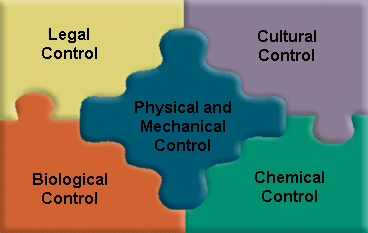Integrated Control
Just as ground, air, and naval forces are integrated to achieve military objectives, the tactical weapons of pest control can also be integrated to achieve more effective management of pest populations. Development of resistance, effects on non-target organisms, and damage to the environment can all be minimized with selective and judicious use of multi-faceted control tactics. This approach, commonly known as integrated control, requires an understanding of ecological principles as well as a thorough knowledge of the pest’s life history and population dynamics.
Integrated pest control is not a new concept. It was commonly practiced in the years before synthetic organic insecticides became widely available. But the old ways were largely abandoned after World War II because chemical weapons were so effective, convenient, and inexpensive. Once we recognized the dangers of over-dependence on a single control strategy, the principles of integrated pest control gained renewed acceptance.
 Today, integrated pest control forms the foundation of Integrated Pest Management programs (IPM) that take a comprehensive and multi-disciplinary approach to solving pest problems. Insects, weeds, plant diseases, and even some vertebrate pests (e.g., birds and rodents) are included under the IPM umbrella. These programs emphasize management rather than eradication. They take a broad ecological approach to pest problems, focusing on all members of a pest complex in an effort to identify the optimum combination of control tactics that will reduce pest populations below economic thresholds and maintain these levels with the least possible impact on the rest of the environment. This approach, often called biorational pest control, relies heavily on cultural and biological tactics that are supplemented with carefully timed applications of highly selective chemical weapons.
Today, integrated pest control forms the foundation of Integrated Pest Management programs (IPM) that take a comprehensive and multi-disciplinary approach to solving pest problems. Insects, weeds, plant diseases, and even some vertebrate pests (e.g., birds and rodents) are included under the IPM umbrella. These programs emphasize management rather than eradication. They take a broad ecological approach to pest problems, focusing on all members of a pest complex in an effort to identify the optimum combination of control tactics that will reduce pest populations below economic thresholds and maintain these levels with the least possible impact on the rest of the environment. This approach, often called biorational pest control, relies heavily on cultural and biological tactics that are supplemented with carefully timed applications of highly selective chemical weapons.
The complexity of modern IPM programs will continue to increase as we add more knowledge about pests, develop new management tactics, and learn how to optimize existing control strategies. Mathematical models of population growth rates and plant-pest interactions are being developed and incorporated into computer programs that help us assimilate and interpret data from the many different variables that affect pest population dynamics. These computer programs, usually known as expert systems, are yet another tool in our expanding stockpile of pest control technology.
Integrated pest management is also a major component of Sustainable Agriculture, a holistic approach to modern farming that encompasses not only pest control, but also conservation of soil and water resources, and a wide range of other management practices (e.g., composting, mulching, green manure, waste disposal, etc.). The goal of sustainable agriculture is to satisfy human needs for food and fiber while preserving nonrenewable resources, protecting environmental quality for future generations, and safeguarding the profitability and long-term viability of commercial agriculture.
But regardless of what it is called or how it is packaged, the basic steps of integrated pest control remain the same:
- Identification. Detecting the presence of a pest and identifying it to species. Closely related species may be very similar in appearance, but have significantly different pest potential.
- Quantification. Sampling to measure population density. How is population density changing with time?
- Determination. Finding out where the population stands relative to economic injury levels. How much more growth potential is left in the population?
- Specification. What type of control is warranted? What tools or resources are needed to implement a control operation?
- Application. Taking whatever steps are necessary to suppress the pest population.
- Evaluation. Confirm efficacy of control tactics by resampling. Re-evaluate the situation and take appropriate actions if needed.

